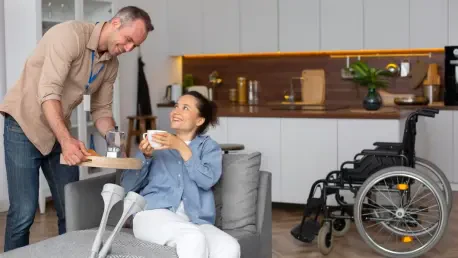Understanding the Disability Housing Landscape in Australia
Imagine a system designed to empower individuals with disabilities, yet thousands of purpose-built homes stand empty while many still reside in outdated, unsafe environments, highlighting a critical gap in support. This stark reality defines the current state of disability housing in Australia, where the National Disability Insurance Scheme (NDIS) serves as a cornerstone for support, aiming to provide tailored assistance to over 500,000 participants by enabling access to housing and care that align with individual needs. However, despite its ambitious goals, systemic gaps persist, leaving many without suitable living arrangements and underscoring a pressing need for reform.
Central to this landscape are diverse housing models such as group homes and Individualized Living Arrangements (ILAs), also known as Independent Living Options (ILOs). Group homes, traditionally the dominant model, house multiple individuals under shared care, often prioritizing efficiency over personalization. In contrast, ILAs offer a more flexible approach, allowing participants to live independently in their own spaces or with a live-in supporter, fostering choice and dignity. These models represent a shift toward empowerment, yet their adoption remains uneven due to structural and financial constraints.
Key stakeholders, including disability advocates, policymakers, and organizations like the Summer Foundation, play a pivotal role in shaping this sector. Advocacy groups push for innovative solutions, while policymakers grapple with balancing budgets and social outcomes. Systemic inefficiencies, such as unoccupied disability homes, and ethical concerns, including reports of neglect in group settings, further complicate progress. These challenges underscore the urgency of addressing not just availability, but also the quality and suitability of housing options for those with disabilities.
Current Trends and Innovations in Disability Housing
Emerging Solutions and Advocacy for Change
Amid mounting evidence of group homes failing to meet modern standards, a significant movement toward alternative housing solutions like ILAs has gained traction. Concerns over inefficacy, coupled with documented cases of abuse in shared facilities, have fueled public and policy discourse. Investigative reports, such as those exposing over 1,000 unoccupied disability-specific homes, have amplified calls for change, painting a picture of a system struggling to deliver on its promises.
Advocacy efforts have crystallized in major recommendations, notably from the 2023 Disability Royal Commission, which proposed phasing out group homes over a 15-year period. This long-term vision seeks to replace outdated models with arrangements prioritizing individual autonomy. Media exposés have further catalyzed public awareness, pushing safety, personal choice, and independence to the forefront of housing reform discussions, with ILAs emerging as a viable path forward.
The emphasis on tailored living environments reflects a broader cultural shift toward recognizing the diverse needs of NDIS participants. Innovations in support structures aim to ensure that individuals can live in settings that not only meet basic requirements but also enhance quality of life. This growing consensus among advocates and affected communities signals a pivotal moment for reimagining how disability housing can evolve to better serve its purpose.
Data and Insights on Housing Adoption
Recent data underscores the slow but steady uptake of ILAs, with nearly 1,500 NDIS participants claiming support for such arrangements in the last financial year. This figure, while modest compared to the total number of participants, indicates a budding preference for personalized living options over traditional setups. It also highlights a tangible starting point for scaling up these models with the right policy backing.
Looking ahead, the potential for ILA growth appears promising, driven by persistent advocacy and evolving policy frameworks. Projections suggest that with increased awareness and systemic support, adoption rates could rise significantly over the next few years. However, this hinges on addressing barriers like accessibility and ensuring that resources are in place to match demand with supply.
The numbers also reveal a critical need for targeted interventions to bridge gaps in understanding and availability. Many participants remain unaware of ILAs as an option, while others face logistical hurdles in transitioning to such setups. Strengthening outreach and infrastructure will be essential to translate current trends into widespread, sustainable change in the disability housing sector.
Challenges in Transforming Disability Housing
The transition from group homes to more individualized models like ILAs is fraught with obstacles that test the resilience of both participants and the system at large. Systemic inefficiencies, such as delays in funding approvals and a shortage of suitable accommodations, often leave individuals stuck in suboptimal conditions. Additionally, a lack of awareness about alternative options further stifles progress, as many remain unaware of choices beyond conventional setups.
Financial and logistical barriers compound these issues, particularly for NDIS participants navigating complex needs. The cost of establishing independent living arrangements, coupled with the scarcity of live-in supporters, poses significant challenges. For the government, aligning individual aspirations with budget-conscious solutions remains a delicate balancing act, often resulting in compromises that limit the scope of reform.
Overcoming these hurdles demands creative strategies, including policy incentives to attract supporters and greater collaboration between public and private sectors. Streamlining administrative processes could also reduce delays, while investment in training programs might address the shortage of qualified caregivers. Tackling these challenges head-on is crucial to ensuring that the vision of personalized housing becomes a reality for more individuals with disabilities.
The Role of Tax Reforms in Disability Housing Policy
Navigating the regulatory landscape of disability housing reveals a complex interplay between the NDIS framework and government priorities aimed at cost reduction. The NDIS, while groundbreaking, operates under intense scrutiny to manage escalating expenses without sacrificing service quality. This tension shapes policy decisions, often prioritizing fiscal restraint over expansive innovation, and sets the stage for targeted reforms to address specific pain points.
A notable proposal, outlined in a KPMG report commissioned by the Summer Foundation, suggests a transformative tax reform to boost ILA adoption. It recommends exempting payments up to $65,000 for approved live-in supporters from taxable income, creating a financial incentive to take on these critical roles. Such a measure could alleviate supporter shortages, making ILAs more viable for participants while aligning with broader cost-saving goals for the NDIS.
The potential impact of this reform extends beyond mere numbers, promising to enhance compliance with NDIS standards and improve participant outcomes. By reducing financial burdens on supporters, it could expand the pool of willing caregivers, thereby increasing access to personalized housing. This policy shift, if implemented, might serve as a catalyst for reshaping how support is structured within the disability housing ecosystem, offering a practical step toward sustainability.
Future Outlook for Disability Housing in Australia
As the disability housing sector evolves, the integration of tax reforms alongside a heightened focus on ILAs could mark a turning point for accessibility and choice. Current policy debates reflect a growing recognition of the need to move beyond outdated models, with discussions centering on how fiscal tools can drive social progress. The alignment of government priorities with advocacy goals offers a window of opportunity to redefine living standards for NDIS participants.
Emerging innovations in housing models, supported by ongoing parliamentary engagement, point to a dynamic future. Events like the launch of significant reports at federal Parliament signal that disability housing remains a priority on the national agenda. These platforms amplify the voices of advocates and experts, fostering dialogue on how to balance budgetary constraints with the imperative for better living conditions.
The trajectory of this sector will likely depend on sustained collaboration among stakeholders and a willingness to experiment with bold solutions. As debates unfold, the emphasis on empowering individuals through tailored arrangements will remain central. With the right mix of policy support and innovative thinking, the coming years could witness a profound transformation in how disability housing meets both individual and systemic needs.
Conclusion: A Path Forward for Disability Housing
Reflecting on the discussions that unfolded, it became evident that Australia’s disability housing sector stands at a critical juncture, grappling with the limitations of group homes while embracing the potential of ILAs. The shortcomings of traditional models have been laid bare, yet the promise of personalized solutions offers a beacon of hope for thousands of NDIS participants. The exploration of tax reforms, particularly the KPMG proposal, has highlighted a tangible mechanism to enhance accessibility and support sustainability.
Looking back, the dialogue has shifted toward actionable steps, with a clear call for policymakers to prioritize incentives that could expand the pool of live-in supporters. Strengthening public-private partnerships emerged as a vital strategy to address logistical gaps, while targeted awareness campaigns were seen as essential to inform participants of their options. These measures, if pursued, promise to bridge the divide between aspiration and reality in housing reform.
Beyond immediate fixes, the journey ahead demands a commitment to continuous innovation and stakeholder engagement. A renewed focus on aligning policy with the lived experiences of individuals with disabilities is deemed crucial. By fostering an environment of collaboration and adaptability, the foundation is laid for a future where housing not only meets basic needs but also uplifts lives through dignity and choice.









